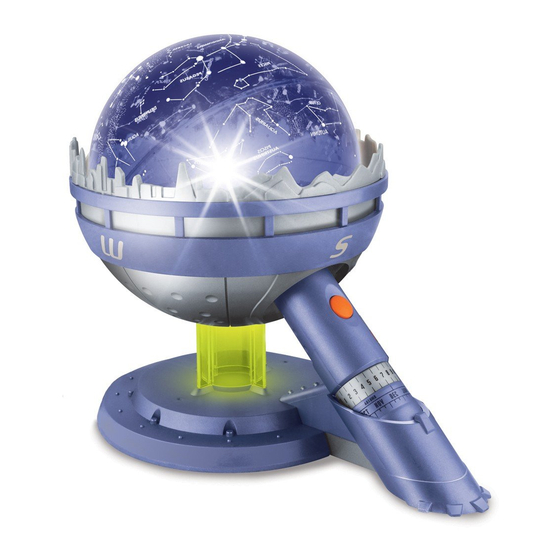Summary of Contents for Uncle Milton Industries Star Theater 2
- Page 1 AGES 8 AND UP 2002 ® Planetarium and Guided Audio Tour Planetarium and Guided Audio Tour Instruction Manual...
-
Page 2: Table Of Contents
Table of Contents Discover the Universe! .......................3 Your Own Planetarium ......................3 What Is a Constellation? ....................3 The Star Sphere ........................4 Planetarium Operation ....................4 Installing Batteries .......................4 Operating Your Planetarium ..................5 Setting the Date and Time ..................6 Care and Maintenance .......................6 Meteors and Comets ......................7 The Constellations... -
Page 3: Discover The Universe
Discover the Universe! Welcome to the amazing world of astronomy! Astronomers spend their time discovering the nature of space and everything in it. As big as our planet Earth is, it is just one of eight planets orbiting the sun, which is just one of billions of stars in our home galaxy, the Milky Way, which is just one of billions of galaxies in the universe. -
Page 4: The Star Sphere
The Star Sphere The Star Sphere is a replica in miniature of the largest and brightest objects in space surrounding our planet. If you were to imagine Earth inside the sphere, it would be located at the exact center, where the light bulb is. The dots printed on the sphere represent stars. The glow-in-the dark dots represent the brightest, easiest-to-find stars. -
Page 5: Operating Your Planetarium
Meteor Maker Align Battery Module with groove Fig. 3 Fig. 4 4. Insert battery module into light Installing Batteries for the Meteor Maker wand, making sure the grooves 1. Snap Meteor Maker holder onto base. align (see Fig. 3). Replace battery 2. -
Page 6: Setting The Date And Time
Setting the Date and Time Fig. 6 Once you’ve taken the audio tour, you can set your planetarium to project the night sky for any date and hour. You can easily adjust your planetarium for any date you wish: your birthday, a holiday, the final day of Time Ring school, last Thursday, or any other date. -
Page 7: Meteors And Comets
5. Reinsert light wand into Star Sphere. Rotate light wand clockwise until it clicks into place. This is important for accurate date and time adjustments. 6. Place Star Sphere and light wand back into base. Meteors and Comets Use the Meteor Maker to simulate a fascinating phenomenon of the night sky, a meteor shower. Insert the meteor image slide in the slot at the front of the Meteor Maker. - Page 8 Andromeda Galaxy Alpheratz Spring Constellations GREAT SQUARE Stars to look for... 1. Big Dipper 2. Regulus 3. Spica 4. Arcturus CETUS CETUS (The Whale) (The Whale) Autumn Constellations Stars to look for... 1. Andromeda Galaxy 2. Alpheratz Capella “Big Dipper” Castor Pollux Deneb...
-
Page 9: The Moving Sky
The Moving Sky Astronomers, ancient and modern, counted on this 24-hour trip, day after year after century. They agreed to divide the east-to-west movement of stars into 24 equal parts. The horizon ring is an important part of your planetarium. It divides the sky into two halves, the Astronomers picked the spot in the sky where the ecliptic (the path the sun takes in relation to visible and the nonvisible. - Page 10 Here are the 25 brightest stars, after the sun, each listed by its common name, the constellation in which it can be found, and the hemisphere from which it is visible: Rank Name Constellation Hemisphere Sirius Canis Major N & S Canopus Carina Alpha Centauri...
-
Page 11: How To Find The Visible Planets
How to Find the Visible Planets O cially, there are eight planets and at least three dwarf planets in our solar system. Four of the planets can be seen without the aid of a telescope or binoculars: Venus, Mars, Jupiter and Saturn. -
Page 12: Planet Information Table
Planet Information Table DISTANCE ORBITAL ROTATION SIZE MASS FROM SUN PERIOD RELATIVE RELATIVE PERIOD (millions of mi/km) (in Earth years) (hours in day) TO EARTH TO EARTH NAME MOONS** RINGS MERCURY 36 / 58 1416 0.39 X 0.06 X VENUS 67 / 108 5833 0.95 X... -
Page 13: Planet Position Tables
Planet Position Tables Source: Gri th Observatory, Los Angeles. 2008 Venus Gem Can Mars Gem Gem Jupiter Sag Saturn 2009 Venus Mars Gem Can Jupiter Cap Saturn 2010 Venus Mars Jupiter Aqr Saturn 2011 Mar Apr May Jun Venus Gem Leo Oph Sgr Mars Gem Cnc... - Page 14 The supply terminals are not to be short-circuited KEEP THESE INSTRUCTIONS FOR FUTURE REFERENCE — DO NOT DISCARD Questions? Comments? Please contact us. We can help! 1-888-742-2484 or go to www.unclemilton.com ® Uncle Milton Industries, Inc. 31186 La Baya Dr. Westlake Village, CA 91362 1-888-742-2484 Fax: 818-707-0878 www.unclemilton.com...


